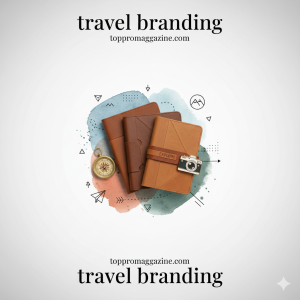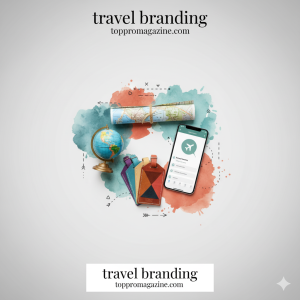In today’s competitive tourism landscape, standing out isn’t just about offering the best destinations or experiences—it’s about creating a brand that people remember and trust. Travel branding plays a crucial role in how travel companies, agencies, hotels, and destinations present themselves to the world. It defines how travellers perceive your business, what emotions your brand evokes, and how effectively you communicate your values. Whether you’re a tour operator or a hospitality brand, having a solid travel branding strategy can turn first-time customers into lifelong advocates. In this article, we’ll explore what travel branding is, why it matters, and how to craft a compelling identity that inspires travellers to choose your brand.
What Is Travel Branding and Why It Matter?
‘Travel branding’ refers to the process of shaping a unique identity for a travel-related business or destination. It involves creating a consistent message, tone, and visual style that resonates with your audience. This can include logos, taglines, social media presence, website design, and even customer experiences.
In the travel industry, emotional connection is everything. Travellers don’t just buy flights or hotel stays—they buy experiences and memories. That’s where branding comes in. A strong travel brand goes beyond products; it communicates a story. For example, brands like Airbnb or Emirates don’t just sell accommodation or flights—they sell belonging and luxury experiences.
Effective travel branding builds trust, which is essential in an industry where customers rely on promises of comfort, safety, and enjoyment. It also enhances visibility in an overcrowded market, giving your business an edge. Whether you’re targeting adventure seekers, luxury travellers, or digital nomads, your brand identity shapes how your audience perceives you—and whether they choose you.
The Core Elements of Successful Travel Branding

Strong travel branding relies on a mix of visual, emotional, and strategic elements that come together to create a memorable identity. Here are the key components:
-
Brand Story and Values
Your brand story explains why you exist and what sets you apart. In travel branding, this story should evoke emotion and aspiration. For example, if your travel agency focuses on sustainable tourism, your story should highlight your commitment to eco-friendly experiences and preserving local cultures. -
Visual Identity
A recognisable logo, consistent colour scheme, and typography create visual coherence. Think of brands like TripAdvisor or Booking.com—their colours and design instantly evoke trust and familiarity. Visual consistency across websites, social media, and print materials is key. -
Tone and Messaging
The way your brand communicates reflects its personality. A luxury travel company might use sophisticated language, while a youth-orientated backpacking service might opt for a fun, casual tone. -
Customer Experience
Travel branding isn’t just about how your company looks—it’s also about how it feels. Every interaction, from booking a trip to post-travel follow-up emails, shapes how customers perceive your brand.
By aligning these elements, you’ll create a cohesive identity that resonates deeply with your target audience and builds long-term loyalty.
Strategies for Building a Memorable Travel Brand
Crafting a strong travel brand requires more than just design—it’s about building emotional connections. Here are proven strategies:
-
Define Your Audience Clearly
Understand who your customers are and what motivates them. Are they luxury travellers seeking exclusivity or adventurers chasing unique experiences? Conducting market research helps tailor your message and visuals to their preferences. -
Leverage Storytelling
Great travel branding tells stories that captivate. Share stories of real travellers, local communities, or behind-the-scenes glimpses of your destinations. Storytelling builds authenticity, one of the most powerful drivers of brand loyalty in travel. -
Embrace Digital Marketing
Use social media, blogs, and SEO to amplify your brand voice. Platforms like Instagram and TikTok are particularly effective for travel branding because of their visual nature. Consistent posting of high-quality visuals and engaging captions can bring your brand to life. -
Focus on Authenticity and Trust
Travellers are increasingly looking for transparency and authenticity. Ensure your brand promises align with actual experiences. Reviews, testimonials, and influencer collaborations can help build credibility. -
Sustainability as a Brand Pillar
Today’s travellers value responsibility. Positioning your brand around sustainable travel—such as supporting local economies or reducing carbon footprints—adds a meaningful dimension to your identity.
When you blend creativity with authenticity, you create a brand that not only attracts attention but also earns loyalty.
The Role of Emotional Connection in Travel Branding

Unlike many other industries, travel is driven by emotion. People travel to escape, explore, and experience something new. Your brand’s ability to connect emotionally can make or break your success.
Emotional branding in travel means identifying what feelings your brand should evoke—excitement, serenity, adventure, or belonging—and designing every touchpoint around those emotions. Airlines like Emirates use luxury and comfort to evoke prestige, while brands like Hostelworld use humour and relatability to connect with budget travellers.
Creating emotional resonance requires consistency. Every marketing campaign, image, and piece of content should reinforce the feelings you want your audience to associate with your brand. Even customer service interactions play a role in strengthening that emotional connection.
When travellers feel emotionally connected, they’re not just customers—they become brand advocates who share their positive experiences, recommend your services, and return for future trips.
Travel Branding in the Digital Era
The rise of digital technology has transformed travel branding. Consumers now discover brands online before ever stepping foot into an office or contacting a representative. This means that your online presence is often your first impression—and it needs to be impactful.
-
Website Design and SEO
A professional, mobile-friendly website is essential. It should reflect your brand’s personality, feature compelling visuals, and be optimised for search engines. Using relevant keywords like “luxury travel”, “adventure tours”, or “sustainable tourism” helps attract organic traffic. -
Social Media Branding
Platforms like Instagram, Facebook, and Pinterest are powerful branding tools. Consistency in visuals, tone, and hashtags reinforces your identity. Using user-generated content, such as traveller photos or testimonials, enhances authenticity. -
Influencer Collaborations
Partnering with travel influencers who align with your values can help amplify your brand’s reach. Their personal experiences and storytelling can introduce your brand to new audiences and build credibility. -
Email and Content Marketing
Engaging newsletters and blogs keep your audience informed and connected. Sharing travel tips, destination guides, and exclusive offers helps position your brand as a trusted authority in the industry.
In a digital-first world, every click, comment, and review contributes to your brand’s image—so maintaining consistency and professionalism is essential.
Conclusion
Travel branding is more than just marketing—it’s the heart of how people perceive and connect with your travel business. A strong brand tells a story, evokes emotion, and creates trust. By focusing on authenticity, emotional connection, and digital presence, you can transform your brand into one that travellers not only recognise but also love. Whether you’re a new travel startup or an established company, investing in branding is investing in your long-term success. Ultimately, great travel branding turns fleeting curiosity into lasting loyalty—and that’s what keeps your business thriving.
FAQs
What is travel branding?
Travel branding is the process of creating a unique identity and emotional connection for a travel-related business, helping it stand out in a competitive industry.
Why is branding important in the travel industry?
Branding builds trust, creates recognition, and helps businesses connect emotionally with their target audience, leading to loyalty and repeat customers.
How can I improve my travel brand?
Focus on storytelling, authenticity, and consistency across all digital platforms. Use visuals and emotional messaging to connect with your audience.
What role does digital marketing play in travel branding?
Digital marketing enhances visibility, builds engagement, and allows travel brands to communicate directly with customers through social media, blogs, and online campaigns.